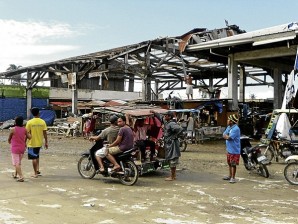Uncertainty stalks typhoon survivors

A HOUSE appears to have survived the onslaught of Typhoon “Pablo” in New Bataan, Compostela Valley, where scores had been killed by the strongest storm to hit the Philippines this year. JEOFFREY MAITEM
MY HOUSE looks like it is still standing, but just like a broken bicycle, its parts are already deformed,” said Angelina Obejas, sighing as her eyes surveyed her house, its roof ripped off at the height of Typhoon “Pablo.”
“It has to be torn down because it’s extremely dangerous to stay in it now,” she said. “But where do you think can we get the money?”
Her house and that of Arsenia Balong’s, her mother, are the last ones standing among the cluster of houses owned by their family in Purok 7, Poblacion, here after Typhoon Pablo battered the place with winds of up to 160 kilometers per hour.
The houses of her two other siblings are all but gone. Only the walls are left standing, wooden ones teetering menacingly on soft, muddy ground.
The task of rebuilding appears to be impossible for Angelina to fulfill. Her family has run out of food, and access to relief goods in the center of town is all but shut. She said she is not used to “begging.”
Article continues after this advertisementAid chaos
Article continues after this advertisementShe once tried to queue for relief goods at a distribution center set up by the municipal government in Compostela, but retreated after she saw how chaotic it was—people shoving and shouting at each other just to be ahead of the line.
Butch Garcia, executive assistant of the mayor, said Compostela town has distributed at least 1,000 sacks of rice to people directly hit by the storm, including those, like Angelina and her family, who are not staying in evacuation centers.
“We know that 95 percent of people in Compostela were directly hit by the storm, so, we included in our relief work those who are not staying in evacuation centers, even if we did not really have to include them,” he said.

TWISTED steel and bare beams are all that are left of the public transportation terminal in Compostela town, which was one of the areas hardest hit by Typhoon “Pablo.” Residents are at a loss as to where to get the next day’s food as aid comes in trickles. GERMELINA LACORTE
“We do that because we know they are affected,” he added, denying claims by some residents that town officials required voters’ IDs before the release of aid.
Compostela Valley Gov. Arturo Uy estimated the total damage to agricultural crops in the province to go up to P4 million.
Getting back on their feet
In Compostela town alone, the Provincial Disaster Risk Reduction and Management Council reported on Dec. 6 that over 1,200 families have been displaced and some P1.1 million worth of crops have been destroyed.
In the whole Compostela Valley province, the storm displaced a total of 123,719 families, injured 222 people and sent missing a total of 406 people.
Uy said the province is still prioritizing relief and rescue efforts to save those who can still be saved.
The province, however, will need all the help it could get from the national government to get back on its feet and save its people from hunger, the governor said.
Angelina’s cousin, Melania Casidsid, went on a mission to search for her two daughters: Aileen, 16, who is about to graduate from high school this school year; and Aimee, 17, a second year accounting student at Compostela’s Legacy School.
Both had been staying with their grandmother, Arsenia, Angelina’s mother and Melania’s aunt, when the storm struck.
Melania was able to talk to her daughters only hours before the storm.
Time to worry
But when a cousin in Barangay Bukal told her how the storm ripped off the roof of Arsenia’s house, forcing the girls to take shelter in another house, Melania began to worry. She tried to call the girls again, but the phone lines were dead.
Melania wanted to be optimistic. But amid the scene of devastation, there seemed to be nothing to hold on to. Hectares of banana plantations had been destroyed. Dry land had become bodies of water. Houses had been reduced to rubble.
Her prayers had been answered, though. She found her girls safe with their grandmother, 75-year-old Arsenia.
Arsenia’s recollection of the storm is vivid. “First it turned this way,” Arsenia said, her arms making circles to the left, to describe the storm. “But after a time, it turned this way,” she continued, circling her arms in the opposite direction.
“It turned to the left at first, so the coconut trees fell in that direction, away from the house,” she said.
“We were all inside my house, all of us, huddled here. We kept saying, if those trees will fall this way, we’re all going to die,” Arsenia said.
Nowhere to go
On the night that people panicked over rumors of yet another flood coming from Cateel town, Melania asked her daughters to return to Nabunturan’s remote barangay of Bukal.
“Why are you going? Are you safe there?” asked Angelina.
“Here we have the Agusan River,” said Angelina, referring to Melania’s house just 30 meters from the Agusan River. “But there, you also have Manat River,” she said, opposing plans to move to Barangay Bukal, where the Manat River is.
“We don’t have anywhere else to go,” said Melania, “So, let’s just stick together.”